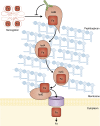Staphylococcus aureus vaccines: Deviating from the carol
- PMID: 27526714
- PMCID: PMC4995089
- DOI: 10.1084/jem.20160569
Staphylococcus aureus vaccines: Deviating from the carol
Abstract
Staphylococcus aureus, a commensal of the human nasopharynx and skin, also causes invasive disease, most frequently skin and soft tissue infections. Invasive disease caused by drug-resistant strains, designated MRSA (methicillin-resistant S. aureus), is associated with failure of antibiotic therapy and elevated mortality. Here we review polysaccharide-conjugate and subunit vaccines that were designed to prevent S. aureus infection in patients at risk of bacteremia or surgical wound infection but failed to reach their clinical endpoints. We also discuss vaccines with ongoing trials for combinations of polysaccharide-conjugates and subunits. S. aureus colonization and invasive disease are not associated with the development of protective immune responses, which is attributable to a large spectrum of immune evasion factors. Two evasive strategies, assembly of protective fibrin shields via coagulases and protein A-mediated B cell superantigen activity, are discussed as possible vaccine targets. Although correlates for protective immunity are not yet known, opsonophagocytic killing of staphylococci by phagocytic cells offers opportunities to establish such criteria.
© 2016 Missiakas and Schneewind.
Figures




References
-
- Auranen K., Rinta-Kokko H., Goldblatt D., Nohynek H., O’Brien K.L., Satzke C., Simell B., Tanskanen A., and Käyhty H.. Pneumococcal Carriage Group (PneumoCarr) . 2013. Colonisation endpoints in Streptococcus pneumoniae vaccine trials. Vaccine. 32:153–158. 10.1016/j.vaccine.2013.08.061 - DOI - PubMed
-
- Black S.B., Shinefield H.R., Fireman B., Hiatt R., Polen M., and Vittinghoff E.. The Northern California Kaiser Permanente Vaccine Study Center Pediatrics Group . 1991. Efficacy in infancy of oligosaccharide conjugate Haemophilus influenzae type b (HbOC) vaccine in a United States population of 61,080 children. Pediatr. Infect. Dis. J. 10:97–104. 10.1097/00006454-199102000-00004 - DOI - PubMed
Publication types
MeSH terms
Substances
Grants and funding
LinkOut - more resources
Full Text Sources
Other Literature Sources

